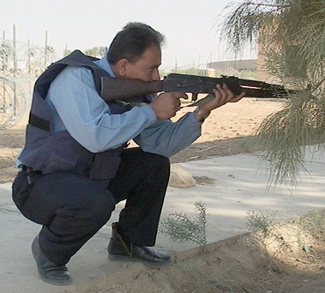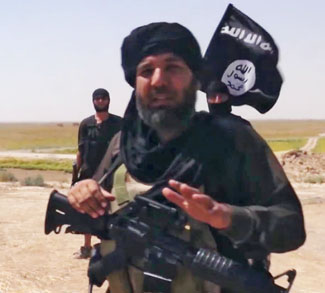Islamic State (ISIS) militants launched a major attack against the main government compound in Ramadi on Friday, sending government forces into retreat following a series of car bombs and firefights. Early reports put ISIS in near-total control of the city – the capital of the restive, Sunni-majority Anbar province.
As of early Sunday, ISIS has pulled back from some districts following a government counterattack, though it remains entrenched in others.
The attack on Ramadi is part of a broader offensive by Islamic State. There are reports of an ISIS presence in Karmah, a strategic town west of Fallujah, and Baghdadi northwest of Ramadi. This latest attack comes after a month of ISIS build-up and minor skirmishes in the surrounding districts.
Most police and military presence in the city have retreated towards Anbar Operations Command, a military outpost across the Euphrates River just north of Ramadi. Fighting has been reported in the area around the base, and it was targeted in the initial attack by no less than three suicide car bombs. ISIS militants are also said to have taken control of the only supply route to the base, complicating the possibility of government reinforcements.
Islamic State going by the guerrilla playbook
An offensive in Anbar province was a natural next move for Islamic State, faced as it was by a high concentration of government and militia forces along the Tikrit corridor on the road to Mosul. By shifting the fight back to Anbar province, it appears that Islamic State succeeded in catching the government by surprise, even though there was no shortage of warnings Baghdad failed to heed.
Islamic State’s guerrilla tactics pose a major challenge to the al-Abadi administration’s approach to liberating ISIS-held territory in Iraq. So far the favored strategy is a slow and meticulous rollback, relying on assistance from Popular Mobilization Front militias outside of urban areas and handing off sole responsibility to the Iraqi security forces (ISF) in major Sunni cities like Tikrit. Such delicacy is warranted by the high stakes in re-taking ISIS-held (mostly Sunni) territory, particularly with the help of Shi’ite militias. Al-Abadi is hoping to avoid any sectarian reprisal attacks that would play into the ISIS narrative of Sunni-Shi’ite conflict and damage Iraq’s national cohesion.
The attack on Ramadi, though a stunning tactical success for ISIS, does not necessarily mean that the city will remain under Islamist control. This could well be a ‘shock an awe’ campaign to spread terror and discord by executing Shi’ites and government collaborators, real or imagined. Though the attack was complex, well-executed, and ultimately successful in achieving its presumed goals, this doesn’t meant that ISIS has the available manpower to hold Ramadi against an ISF counterattack backed up by coalition air power, or that it even intends to do so. We may see ISIS militants pulling back in the days and weeks to come and simply waiting for the next vulnerability to form in ISF deployments.
It appears that this is already happening. Just one day after the black flag went up over Ramadi’s government complex, ISIS militants abandoned it and burned down the adjoining police station, retreating into Ramadi’s residential areas to avoid counterattacks from coalition air power.
Islamic State’s success in Ramadi goes beyond territory
Whether it holds on to Ramadi or not, Islamic State has scored a victory by underscoring its continued relevance despite a string of recent government victories. Months of airstrikes using the most advanced military technology on the planet was supposed to have declawed the militant group, paving the way for a decisive government counterattack. The fall of Ramadi shows that the group is still active and looking to expand its territory. This is a theme that will surely show up in the next wave of ISIS propaganda.
Looking at the big picture, the ISIS attack on Ramadi could influence the politics of the Iraq conflict in a way that is ultimately beneficial to the militant group. It will be seized on by some observers as evidence that the current approach to defeating ISIS is not working. There will be more calls for participation by the Popular Mobilization Front militias in liberating ISIS-held territory, a strategy that could well lead to a new spiral of sectarian killings.
There will also be calls in the United States to arm the pro-government Sunni tribes and the Kurdish Peshmerga directly, bypassing the Iraqi government. Though Baghdad’s stubborn resistance to arming the tribes is an enduring point of contention with Washington (indeed a local Sunni tribe predicted Friday’s attack and repeatedly requested arms and reinforcements from Baghdad to no avail), Washington arming the tribes at this point would almost certainly destroy US-Iraqi bilateral relations and quite possibly set the stage for a protracted civil war and the disintegration of Iraq into its Sunni-Shi’ite-Kurdish constituent parts.
The most sensible way forward would be to carry on with the careful rollback of ISIS’ territorial gains and introduce a new “Sons of Iraq” scheme with Baghdad, rather than Washington, at the helm. An inclusive, national approach is the only way to beat the sectarianism represented by Islamic State, and in this ‘slow and methodical’ is the only viable option.
Unfortunately, the fall of Ramadi makes it all the more likely that cooler heads will not prevail.
Update: As of Monday morning, a government official in Anbar province claims that Ramadi has completely fallen to Islamic State. There are reports of police and military units abandoning their posts and fleeing, leaving weapons and equipment behind, and members of ISIS say they have taken over the 8th Brigade army base.
Prime Minister al-Abadi has responded by ordering the Shi’ite militias to prepare to enter the city in a counterattack.




